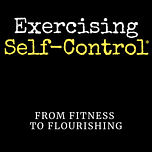Here’s a scenario: It’s 2 in the afternoon and, despite a solid night’s sleep and your usual morning coffee, you’re staring at your computer screen trying to remember what you were in the middle of doing. Your task list awaits while you scroll through social media, grab a pick-me-up snack, or reach for more caffeine.
What you’re experiencing isn’t a personal failing. It’s your body doing what it does. It’s maybe a little inconvenient at times but perfectly natural. So what can you do?
The solution lies in understanding ultradian rhythms, the biological patterns hardwired into our DNA that govern our energy cycles throughout the day. By working with these natural rhythms instead of fighting them, you can dramatically boost your productivity, energy, and ability to focus on the task at hand.
Hey there. It’s me, Kore. And you’re listening to Exercising Self-Control: From Fitness To Flourishing.
What Are Ultradian Rhythms?
Ultradian rhythms are physiological patterns that mirror, on a smaller scale, our 24-hour circadian rhythms. These smaller ultradian cycles oscillate multiple times throughout each day.
These rhythms manage cycles of energy production, output, and recovery in all living organisms, from humans and animals to plants and fungi. They significantly impact our physical, mental, and emotional health, controlling what we perceive as our ability to focus, make decisions, and push through challenging tasks.
The Ultradian Cycle: Your Body’s Natural Schedule
During sustained mental and physical activity your body metabolizes oxygen and glucose while accumulating waste byproducts. This creates a predictable pattern:
Ultradian Performance Peak: Productivity reaches its apex between 60-120 minutes of starting focused work.
Accumulation Phase: Simultaneously, metabolic waste, information fragments, and cellular debris build up in your system.
Ultradian Trough: After one to two hours stress increases and productivity declines as your body enters an energetic low point. The mathematical average is about 90 minutes. The body isn’t this consistent across time, however. It varies across the day and from day to day but most of us have schedules that are set as I’ll address shortly.
Photo by Pawel Czerwinski on Unsplash
A Typical Workday
Here’s what a typical workday might look like when you honour these rhythms. I’m taking the average time, between 60 and 120, at that 90 minute mark. The body, again, isn’t this consistent across time but it’s convenient for our commonly shared schedules.
9:00 AM: Begin focused work.
10:30 AM: Notice your fatigue signals and take a 20-minute walk outside.
11:00 AM: Return refreshed for the next 90-minute cycle.
12:30 PM: Energy dips again. A good time for lunch and a brief rest.
1:30 PM: Resume work with restored capacity.
Recognizing Your Body’s Signals
Your body clearly communicates when it needs an ultradian rhythm break (URB). Watch for these signals: fatigue, grogginess, mentally loopy, irritability, difficulty focusing, hunger, fidgeting, and cravings for sugar, carbs, or caffeine.
Remember, these are signals the body needs attention. Now’s not the time to tough it out and push through. If you have the option to pay attention to the signals, take advantage. There will be times you must push on. Do what you must. For peak efficiency, especially for cognitive function, honour your natural rhythms.
As I’ve said repeatedly: You can’t force your body to change. If it needs attention, make the wise choice.
The Magic of Ultradian Breaks
When you heed these signals and take a break, your body performs some needed recuperation. During this crucial 20-minute window your internal systems:
Refuel and rebalance: Deliver fresh ATP (needed for cellular energy), stabilizes blood sugar, hormones, and neurotransmitters, and flushes toxins.
Perform mental maintenance: Allow your brain to process information, create new neural connections, and generate insights.
If you take the break your systems rapidly return to full capacity for another productive period. Skip it and your next performance peak will be significantly lower than the previous one.
The High Cost of Pushing Through
Our culture glorifies ‘pushing through’ and just ‘grinding’ but ignoring ultradian troughs creates escalating physiological damage.
Immediate effects: Rising inflammation markers, elevated blood pressure, imbalanced blood sugar and hormones, compromised immunity, and disrupted digestion.
Cognitive impacts: Declining mental capacity, memory gaps, increased moodiness, higher error rates, reduced reading comprehension, narrowed peripheral vision, and decreased creativity.
Long-term consequences: Chronic mismanagement contributes to accelerated aging, digestive distress, hormonal imbalances, abdominal fat accumulation, and sets the stage for heart disease, type 2 diabetes, autoimmune disorders, depression, and Alzheimer’s.
Implementing Ultradian Rhythm Breaks: A Practical Guide
Start with awareness: Notice your natural 60-to-120-minute cycles, averaging 90 minutes, and the roughly 20-minute energy troughs that follow.
Take immediate action: At the first sign of depletion, stop what you’re doing and take a break. Twenty minutes is ideal but even five or ten minutes provides significant benefits.
Shift gears completely: If you’ve been sitting, move. If you’ve been intensely focusing, let your mind wander.
Avoid electronic devices and intensive distractions. Scrolling social media may feel relaxing but the brain is getting no rest at all.
Effective URB activities: Use the restroom, drink water, walk outside without your phone, sit and stare off into the distance, meditate, listen to calming music, or perform simple manual tasks like organizing your desk or doing the dishes.
Troubleshooting Common Challenges
“My boss thinks breaks mean I’m slacking.” Share the research: productivity increases with strategic breaks. Propose a one-week trial and track your output.
“I have back-to-back meetings.” Build micro-breaks into your schedule: arrive two minutes early to breathe deeply, step outside during phone calls, or practice brief meditation between meetings.
“I forget to notice the signals.” Set alarms every 90 minutes as reminders to check in with your energy levels. Your awareness will naturally improve with practice.
“My work environment doesn’t support breaks.” Start small. Even bathroom breaks and brief walks to get water can be URBs when done with the intention to shift gears mentally and physically.
Your Rhythm Revolution Starts Now
The more you understand and respect your ultradian rhythms the better you perform both physically and mentally. These are the requirements for sustainable high performance.
You can think of the URBs as the micro-version of sleep. You’re not taking a nap but you are getting the vital repair and rebalancing needed to pick up with energy when you get going again.
Try this one-week challenge: Set a timer for every 90 minutes and honestly assess your energy level. When you notice depletion signals take a 10-20 minute break doing something completely different from your previous activity. Track your productivity, mood, and energy throughout the week.
Your body is the result of millions of years of evolution perfecting these rhythms. It’s time to stop fighting and start leveraging the natural rhythms for the productivity, energy, and mental clarity that you’ve been seeking.
That’s it for today. Catch you next time.











